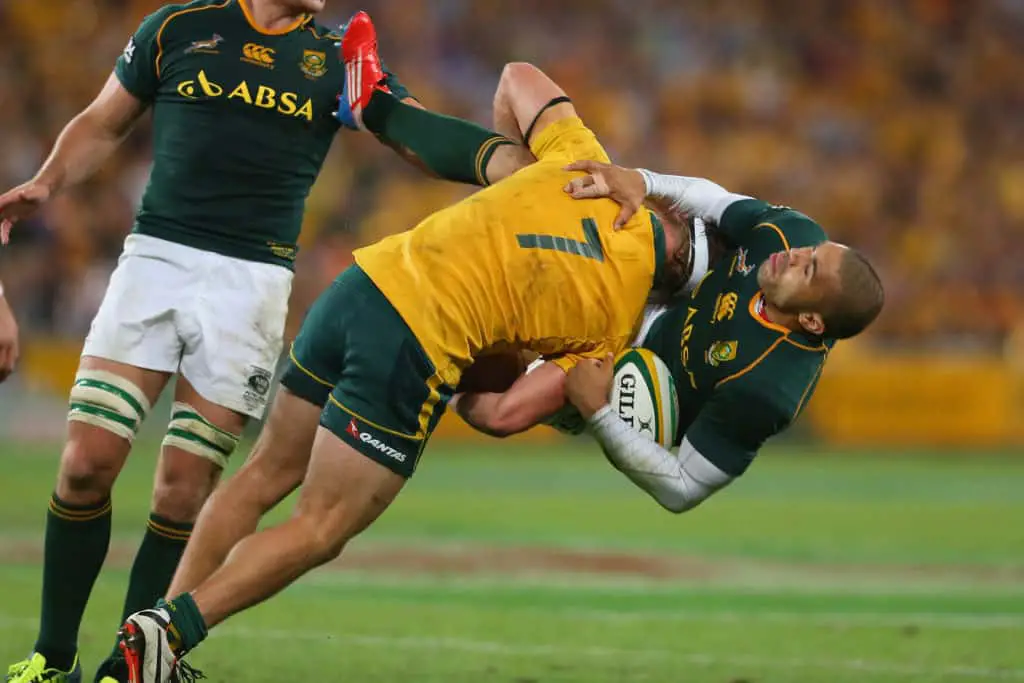
If you want to be a good rugby player then you need to be able to make tackles in your sleep. The process of going from a tackling newb to an expert is one filled with ups and downs and potential pitfalls. To ensure you become a tackling master as quickly as possible we will break down exactly how you should be learning the fine art of throwing rugby players to the ground.
How do you practice rugby tackling?
To practice rugby tackling you need to start with no contact drills where you learn how to get into the right position. Then you practice contact drills involving tackling shields. Finally you practice full contact tackling drills.

No Contact Tackling Drills
Too many rugby players are dropped off at the deep end when first learning to tackle. They go from never tackling before straight into contact drills. This is far too big of a step which results in many new players developing bad habits, which can be difficult to correct at a later stage.
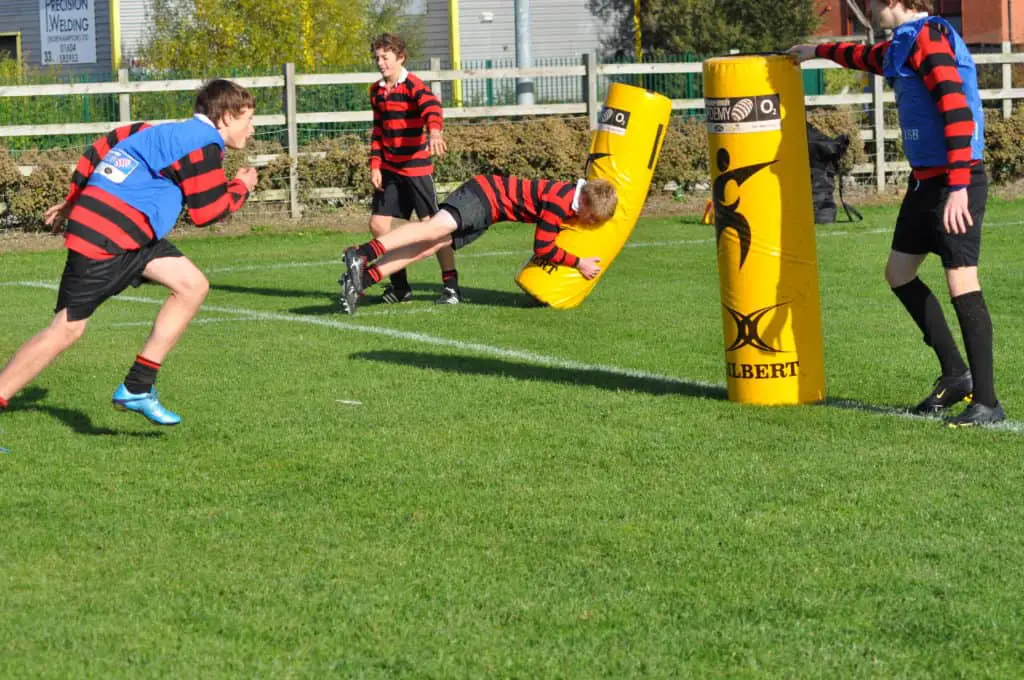
Before you progress to contact drills you need to start with no contact exercises. No contact exercises will teach you how to move and position your body so when it comes time to put a hit on you will be able to perform a powerful tackle effectively and safely.
A simple drill to start with is practicing your tackling stance and body height. When tackling you need to be in a staggered stance with one in front of the other. As you are about to make contact you need to step your front foot as close to opposition as possible and then lower your body height by squatting down and placing your weight on your back foot.
To practice this you can simply place a cone in front of you, then get yourself in a staggered stance and practice stepping your foot close to the cone. Once you step next to the cone then lower your body weight and load up your weight on your back foot. When performing this drill visualise the cone is your opposition. Perform this drill until you can effortlessly step close to your opposition and get into an ideal low position.
If you have a teammate they can replace the cone. You can get them at first to just stand still and you can practice stepping in close. Once you have mastered that you can get them to slowly jog straight and repeat the same drill. After you have got the hang of that you can get your teammate to run faster and also start running at different angles.
With a teammate you can also practice your shoulder and head positioning when making contact during a tackle. When tackling you want to hit your opposition with your shoulder between their lower rib cage and their lower thigh. You want to ensure your head is outside of their body to avoid being hit and concussed by a flying elbow, knee or a sharp hip bone.
To practice this without contact simply get your teammate to stand still and make touch contact with your shoulder with your head outside their body. You can combine this with the aforementioned drill where you practice stepping or you can just focus on the shoulder and head positioning.
You need to drill this until it is ingrained in your muscle memory because when you are playing a rugby match and a player is sprinting at you, you won’t have time to think where you should place your head or shoulder. You have to react.
By practicing these non contact drills you will be able to teach your body how to get into the ideal position to make a tackle in a low stress relaxed environment. Once you understand how to move properly when making a tackle you are now ready to move onto some more intense contact drills.
Contact Tackling Drills
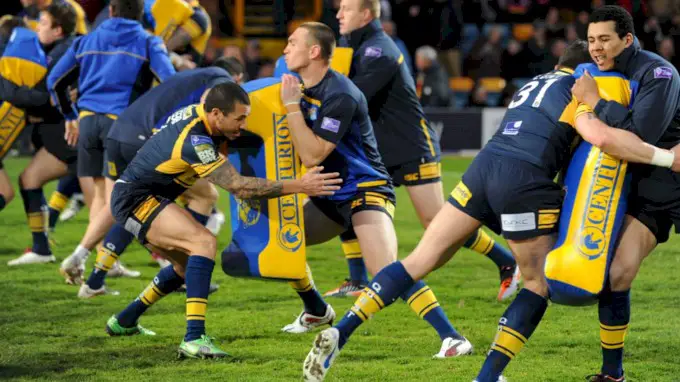
You should not leap from performing non contact drills straight into full blown contact where you are attempting to make tackles in the open field. This is too big of a progression and will lead to eating a face full of grass or getting injured. Instead you need to make a slow progression.
Your first taste of contact tackling should involve tackling shields. A good drill to start with is having your teammate slow jog towards you in a straight line and you practice making solid shoulder contact.
Incorporate all the movements that you practiced in the non contact drills but just at the end drive your shoulder into the tackle shield. To give your tackles extra power you want to drive off the ground with your back foot. Make sure you keep a straight back and neck by looking slightly up when making contact.
Once you have made contact with your shoulder your job isn’t over. It is time to practice some leg drive. You need to keep running through the tackle by continually moving your legs. The leg drive should be instantaneous from the time you make contact with your shoulder, there should be no pause.
At first you need to make a conscious effort to remember all steps involved (stepping close, lowering body height, keeping straight back, hitting with shoulder, driving with legs) as it will be easy to forget a few. After practicing this drill for a while it will become second nature and you will look like a pro when tackling the shields.
Once you have the hang of tackling a shield it is time to actually practice tackling your teammates. There are many different full contact tackling drills you can practice, here are a couple I recommend.
Drill 1. Set up a ruck
Have a half back run the offense
Half back will call pick and go or pass to a forward who will take a hit up
Defensive line will be 3 man wide
Each players practices 10 tackles, combination of pick and gos and one out hit ups
This a great drill to practice ruck defense it will help you practice tackling in close quarters and communicating with your teammates while in defense.
Drill 2. Mark out a square, 5X5m
One player runs with ball and tries to score
Defender tries to tackle
This drill is a good introduction to open field tackling. You won’t have any of your teammates to help you out in defense and the attacker will have a little room to get up some speed and put a step on. The secret is to get up on the attacker quickly before they can get into a sprint.
How To Practice Rugby Tackles By Yourself?
To practice rugby tackling by yourself you can work on your contact and leg drive by tackling a boxing bag, long tackling shield or a scrum machine. To train footwork you can set up cones and practice stepping, lateral and vertical movement.

Rugby is a team sport and is best practiced with others. However, you do not always have access to training partners. Don’t fear, you can still improve your rugby skills, even your tackling abilities by performing some solo drills.
If you want to practice tackling and have no teammates to hit then go down to your local footy field and practice hitting the scrum machine and long tackle bags. It won’t be as good as tackling your teammates but it will still allow you to practice dropping your body height, making contact with your shoulder while keeping a straight back and driving with your legs.
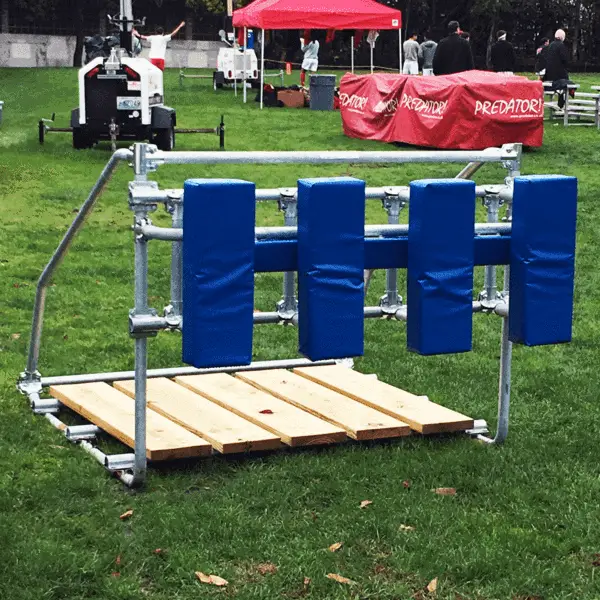
Having no training partners is no reason you can not improve your tackling footwork. To work on your footwork place a number of cones in different directions, vertically, horizontally and diagonally. Visualise there is an opposition ball runner in front of you and practice moving within the cones.
For example visualise a ball runner running away from your outside right shoulder at pace, quickly move to the diagonal cone, step with your front as close to the cone possible, drop your body height and see yourself making the tackle.
When footy starts again your teammates will be surprised by how much your tackling ability has improved from performing these solo drills. They will be convinced you have been doing some secret training with another team.
Conclusion
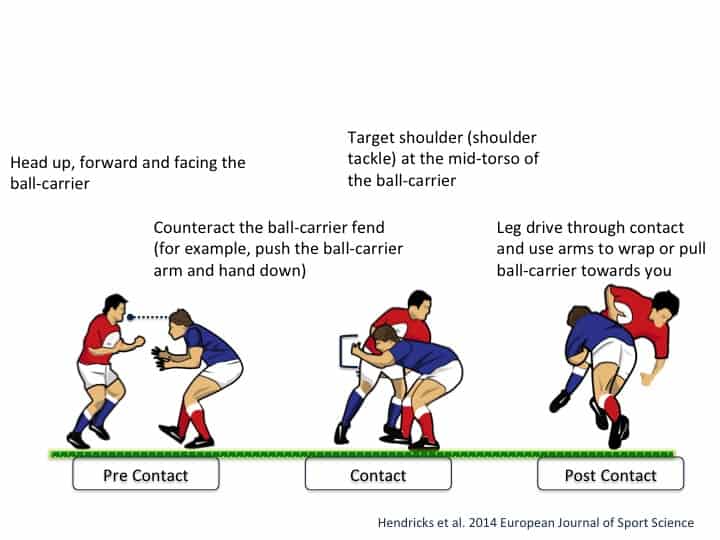
Tackling in rugby is a tricky skill to learn. It is often taught poorly as too many coaches throw their players immediately into full contact drills without teaching them the basics. To ensure you develop strong tackling technique first begin with no contact drills where you work on your body mechanics, then contact drills with tackling shields to practice shoulder contact and leg drive before finally progressing to full contact tackling practice.
If you don’t have any rugby training partners to practice tackling with, don’t worry. You can still develop your skills by practicing by yourself. You should practice your contact and leg drive by tackling the scrum machine and long tackle bag. To practice your footwork, set up cones and visualise attackers running at you as you step within the cones to get into an ideal tackle position.
